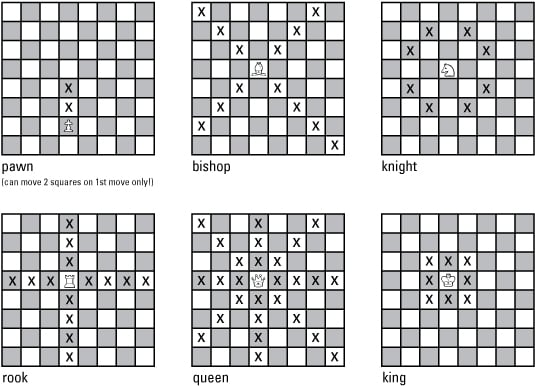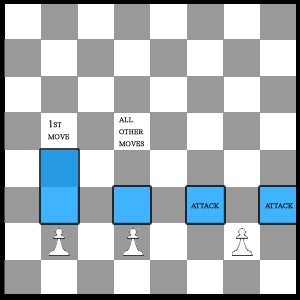How Many Spaces Can A King Move In Chess
How to Teach Children Chess. Chess is a great game that can teach children how to think strategically and analyze situations. Start with the basic concepts such as the different pieces and the. BrainKing - play online chess, checkers, backgammon, reversi, pente and other popular board games and variants on the internet. King: The king can move in all directions (horizontally. Rook: The rook can move horizontally or vertically (up,down,left or right) as many spaces as it. As v all know in chess the main objective is to protect the king. So y does the king get only one step. The queen can do anything that the other pieces can the castle can move straight.
Chess is a game that people have been playing for centuries in some form or another. The original form of chess likely came from India sometime between 280 and 550 BCE. This original game was played with pieces known as the infantry, cavalry, elephants and chariot. Eventually, these pieces became the modern pawns, knights, bishops and rooks.
The Silk Road enabled the spread of the game throughout the Muslim world and the European and Asian continents. The oldest known chess manual has been referenced in various written works and dates back to approximately 840 to 850 BCE. This manual was written in Arabic and although the original document was lost, several other manuscripts refer to its existence. Other evidence of the existence of chess throughout history includes chess pieces dating back to approximately 760 BCE that were discovered in Uzbekistan.
By the year 1000, chess had spread throughout the European continent. Around 1475, chess began to evolve into its modern form. Several important things occurred around this time, including the introduction of the queen piece. Later in the nineteenth century, chess rules began to take on a more standardized and official form than they had previously had.
Modern chess boards are made up of eight rows and eight columns that make up a total of 64 squares. These squares are alternatingly light and dark colored. Boards are placed so that the light squares are at the right-hand sides of each player. Chess pieces are typically white and black, with 16 total pieces per player: one king, one queen, two rooks, two bishops, two knights and eight pawns.
The pieces on the back row are placed from the right-hand side of the board to the left-hand side in the following order: rook, knight, bishop, queen, king, bishop, knight, and rook. The second row of pieces consists entirely of pawns. Each player’s queen must go on the square that has the same color of the piece; the white queen goes on the white square and the black queen on the black square.
The player with the white pieces makes the first move. Both players may only make one move per turn and must move their pieces to either an empty square or to a square with their opponent’s piece so as to capture said piece. Captured pieces are removed from the board. Players cannot make moves that would leave the king piece vulnerable or in check. They also cannot pass turns. If a player cannot make a legal move during his or her turn, but is also not in checkmate, then the game will end in a draw.
The rules for moving individual pieces are as follows. Pawns may only move forward one space at a time, with the exception of the very first turn when a pawn may move forward two spaces. Pawns capture other pieces by moving forward by one space in a diagonal direction. Pawns cannot capture pieces that are directly next to them horizontally or vertically. Rooks can move as many squares as the player would like in either a horizontal or vertical direction along the board, as long as the piece does not jump over another piece. Knights move in an ‘L’ shape, meaning that in one move they can go one space horizontally and two spaces vertically or two spaces horizontally and one space vertically. Unlike other pieces, knights are permitted to jump over other pieces. Bishops, like rooks can move as many spaces as the player would like as long as they do not jump over other pieces. The difference between rooks and bishops is that bishops may only move in a diagonal position along the board. The queen can move in any direction and as many squares as the player wishes as long as the piece does not jump over any other pieces. The king can move one square in any direction.
The object of chess is to put the king in checkmate, which means that piece is under attack and cannot legally move to another space so as to avoid the attack. The move prior to checkmate is referred to as being in check. The only legal move while in check is to move the king to a space where it will not be under attack.
Chess is played throughout the world. Additionally, many variations of chess exist. These variations typically entail a change in the rules, piece placement, board size, board shape, or some combination of these things.
Comparisons to other types of games
Other games that use strategy and predictive maneuvering can be found in the games of casinos. Many have compared the game play of poker, blackjack and even Roulette to the same strategy patterns applied to the game of chess. More information can be found here.
Go is another strategy board game that is often compared to chess. Go is a game that combines both strategy and intuitive decision making. More information on Go can be found here.
Some variations of chess utilize a standard chessboard and standard chess rules but with a different number of pieces or different starting positions for the pieces. Examples of games with different starting positions include chess960, displacement chess, Moab chess, upside-down chess and monster chess. Some variations such as chess960 or Moab chess involve pieces that are selected and placed randomly. Others such as upside-down chess have pieces that are placed on the opposing player’s side of the board, with player’s playing the game in an ‘upside-down’ manner. Additional online games can be found here.
Variations that use different numbers of pieces include charge of the light brigade, Dunsany’s chess, endgame chess, handicap chess, peasants’ revolt and weak. In these games, players may have the same pieces as each other, such as in endgame chess where both players have only pawns and one king. Others such as charge of the light brigade entail players having different pieces from each other. In this variant, both players have similar pieces with the exception of one side having three queens and the other having seven knights.
Chess games played on non-traditional boards include active chess, chess attack, circular chess, cylinder chess, hexagonal chess, double chess, infinite chess, three-dimensional chess, and many others. Board shapes can vary greatly and may include two combined chessboards with two full sets or pieces as in doublewide chess, or they may be unusually shaped such as with infinite, hexagonal or cylinder chess.
Another chess variant involves a standard chess board with standard pieces but different rules. These rules could affect the pieces’ abilities, allow players to make multiple moves per turn or add some element of luck or chance to the game. Examples of these include friendly fire chess, where a player is able to capture his or her own pieces in addition to the opponent’s pieces, Marseillais chess, where players can make two moves per turn, and dice chess, where players roll dice to determine their moves.
Players have several unique moves available to them so as to strategically place their pieces. An important element of chess is for a player to control the most space on the board, as having more space can be equated with having more options as far as making a move. Some special chess moves exist that may allow a player to gain the advantage over his or her opponent. These moves are referred to as capturing en passant, castling and pawn promotion.
A pawn can capture another pawn en passant. The term en passant is French for ‘in passing’. The opportunity to make this move occurs when an opponent pawn moves to a square that is adjacent to one’s own pawn. This move must be made immediately after the opponent places his or her pawn in this position and is made by moving the pawn to the diagonal square above the square containing the opponent’s pawn. The opponent’s pawn is then captured en passant.

Castling is a move that uses both the king and a rook. In order for a player to utilize this move, he or she cannot have yet moved either the king or the rook. Also, the king cannot be in check and there must be no other pieces between the rook and the king. The move is made by moving the king two squares toward the rook. The rook then goes onto the square that the king crossed. This is the only chess move in which two pieces are permitted to move during the same turn.
Pawn promotion is an interesting move that allows a player to exchange a pawn for another piece of his or her choosing. Pawn promotion occurs when a pawn reaches the opposing player’s side of the board. At this point, the player can select which piece the pawn should become. He or she is allowed to choose any piece, which means that pawn promotion may allow for two queens to exist within the game.

With recent events in the world we are very grateful to our sponsors and their online casino nz website. Additionally, please look forward to our Twitch broadcasts for instructional chess in the near future.
A Chessboard is square: eight columns long and eight rows wide. The chessboard needs to be placed so that the square in the lower right-hand corner facing each player is white.
How Many Spaces Can A King Move In Chess
